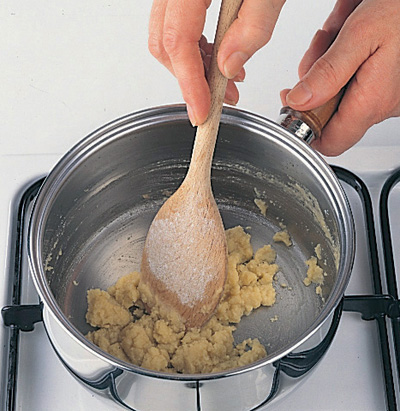When you deglaze meat juice with wine or stock, it develops a more intense taste.
A good sauce or dressing can add color, flavor and even texture to an uninspiring dish. Rediscover this kitchen skill, once considered an essential culinary accomplishment, and create inspiring accompaniments for salads, pasta, rice and roasts.
Wine, all-purpose flour, cornstarch or puréed vegetables all contribute to good gravies. Oil and vinegar are the starting point for a tasty dressing.
Deglazing is the simplest way to get a good base for a meat gravy.
• After browning, remove the meat from the pan and add water, stock or wine.
• Bring to the boil, stirring constantly, to incorporate the dried meat juices and fat.
Thickening gives gravy the right consistency and improves flavor. Here are some tried and tested tricks.
• Purée vegetables cooked in the meat stock to thicken gravy and add taste.
• Add 2 teaspoons (10 ml) cranberry sauce or red currant jelly to give gravy a fruity kick.
• When braising meat, add a few small pieces of bread to the pot: They will disintegrate and make the meat stock creamy.
• All-purpose flour and cornstarch are good thickeners. Just stir them into a little water and add to the gravy before bringing it to a boil. If you use half all-purpose flour and half cornstarch, gravy turns out thinner and lighter.
• A roux is a mixture of equal amounts of fat and flour, which is then cooked and combined with liquid to make a base for sauces. For a béchamel sauce, add milk to the basic roux; for brown sauce, add some meat or dark vegetable stock.
• A mixture of flour and butter (beurre manié) is good for thickening sauces shortly before serving. Work them together in equal proportions, then pull off small pieces and whisk them into the boiling sauce or gravy. Mixed flour and butter keeps for 2 weeks when refrigerated.
• Shortly before serving, sour cream, crème fraîche or thick cream can be beaten into a meat stock to thicken it.
• Mix a few spoonfuls of gravy with an egg yolk and add to the rest of the hot gravy while stirring constantly. Don’t let the liquid boil or the egg yolk will “scramble” and make the gravy lumpy.
• Season roux-based gravies only after thickening. Don’t forget to taste them before and after seasoning.
• Boil a gravy thickened with roux for at least 5 minutes to eliminate the floury taste. Add herbs such as thyme or sage to give gravy extra flavor.
• Prevent a skin from forming on light gravies by drawing a piece of butter over them with a fork.
• To enrich a gravy with butter, remove the pan from the heat and add the butter one piece at a time, letting it melt while swirling the pan a little.
• Whisk gravies vigorously to be sure they are creamy and free of lumps.
• To test the consistency of gravy, dip a wooden spoon into it. The gravy should coat the spoon.
• You can make gravy go further and add another flavor by adding stock, sour cream, cream, crème fraîche, wine, sherry or even the water from cooking vegetables or pasta.
• For perfect smoothness, strain gravy before serving.
1 Melt or sauté 4 teaspoons (20 g) butter in a pan and add 4 teaspoons (20 g) flour, while stirring vigorously with a spoon.

2 Keep stirring until the flour blends with the butter. To make a dark roux, lightly brown the butter–flour mixture.

3 Add your liquid (stock, water, milk, etc.) and bring to a boil, stirring constantly until the sauce thickens.
Vinaigrette is still the classic salad dressing—although it tastes good with fish and meat dishes, too—but it requires high-quality ingredients in the right proportions to work its magic.
• If you remember this one simple rule, you will never have to consult a vinaigrette recipe again: Use vinegar and oil in a 1:3 proportion. If you are adding mustard, use about 1 teaspoon (5 ml) per 3 tablespoons (45 ml) salad dressing.
• Stir some salt and pepper into the vinegar, and whisk in the mustard. Gradually pour in the oil while stirring constantly, until the vinegar and oil combine to form an emulsion.
• If the ingredients start to separate, beat the vinaigrette vigorously again.
• If you are in a hurry, put the vinaigrette ingredients in a lidded jar and shake to combine.
• If the vinaigrette is too oily, add more vinegar, mustard and spices. If the vinaigrette tastes sour, add oil and salt. A little sugar won’t hurt, either.
• You can make a vinaigrette in advance. It will keep in the refrigerator for about 3 weeks. Shake it thoroughly before use.
• You can vary the basic vinaigrette recipe by adding crushed garlic, mayonnaise, nuts, dried fruit, sesame seeds or herbs, depending on the dish to be served.

Use the correct proportions of oil and vinegar to make the perfect vinaigrette.